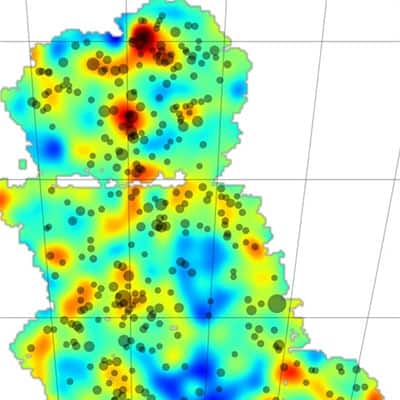
The largest high-resolution and contiguous map of dark matter in the universe has been unveiled by the Dark Energy Survey. The researchers who created the map say that it demonstrates the potential for a technique based on weak gravitational lensing to be used for studying dark matter and dark energy. Called “cosmic shear”, the technique is now being used to regenerate a full-sized 3D map, which should be completed in 2020.
Dark matter is an invisible entity that appears to interact only through gravity. Physicists believe it accounts for four-fifths of the matter in the universe and, while they have some ideas as to what it could be made of, it has never been detected directly.
Dark energy is even more elusive. It is the general label for the unexplained observation that the expansion of the universe is accelerating. This is contrary to the basic prediction of Einstein’s general theory of relativity, which suggests that gravity should be slowing the expansion down. The easiest way to model this acceleration is to add a “cosmological constant” to the equations of general relativity. However, no-one is sure what this constant should represent physically, or whether it has been a constant throughout the lifetime of the universe.
Galaxies and supernovae
The Dark Energy Survey (DES) is a collaboration of research institutions in the US, Brazil, the UK, Germany and Spain that aims to gain insight into these two mysterious entities. The survey uses a 4 m optical–infrared telescope at the Cerro Tololo Inter-American Observatory in Chile. This instrument can peer eight-billion years into the past, with the ultimate goal of mapping hundreds of millions of galaxies and thousands of new supernovae, as well as all of the dark matter in-between.
The astronomers are interested in dark matter because the way that it clumps together reveals something of the nature of dark energy. If dark matter was not so clumpy in the distant past, then that might suggest that dark energy was not stretching it out as rapidly as it is today. And that in turn might suggest that dark energy is not best represented by a cosmological constant, after all.
Starting point
Since the DES began in August 2013, the collaboration has released a few small test maps charting regions known to have a high density of dark matter. Now, the team has released what it claims is the biggest contiguous map of dark matter in high definition. “For me, it’s the starting point of where we’re going to go with the Dark Energy Survey,” Sarah Bridle, an astrophysicist at the University of Manchester in the UK and a member of the DES, told physicsworld.com. “We’re getting 30 times this area over the next five years.”
The density of dark matter was computed with data from the DES using a relatively new technique known as “cosmic shear”. This is a weak form of gravitational lensing whereby light is bent from its normally straight path by a gravitating mass. Cosmic shear makes galaxies appear to be orientated in a biased direction – not randomly, as is actually the case. By analysing these orientations statistically, astrophysicists like Bridle can work out how much dark matter there is, and where.
Large and lovely filaments
The DES map offers no great surprises. It reveals that dark matter exists in large filaments that link together the visible galaxies and galaxy clusters. Astrophysicists knew this already, not least from projects such as the Canada–France–Hawaii Telescope Lensing Survey, which has already produced dark-matter maps of similar resolution, albeit not so big. According to Bridle, however, the DES map is a “proof of concept” that cosmic-shear methodology works well on large scales, and could help other astrophysicists study galaxy formation. “And the pictures look lovely,” she jokes.
The current map charts 150 square degrees of sky, and was produced using computing resources equivalent to running 500 ordinary desktop computers for two weeks. That is just a small fraction of the 5000 square degrees expected over the next five years from the full DES map, which will allow proper tests of the most popular model of how the universe is evolving – the lambda-cold-dark-matter model. “If there was a departure from that model, that would be major news,” says Bridle. “And that’s something that could come out of the survey in the next five years.”
The DES map and analysis will be uploaded to the arXiv preprint server on Tuesday 14 April.
- In the video below, Luke Davies of the University of Bristol explains the fundamental physics of dark matter.



